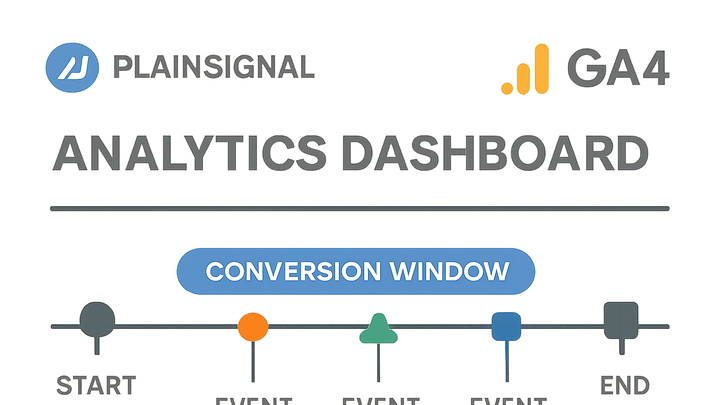Published on 2025-06-27T20:41:31Z
What is Conversion Window? Examples for Conversion Window
The conversion window, also known as the lookback or attribution window, defines how far back in time analytics systems will attribute a conversion to a specific user interaction. It sets the maximum length of time between a user’s touchpoint—such as an ad click or email open—and a subsequent conversion event to be considered related. Selecting an appropriate conversion window is crucial: too short, and you may undercount marketing effectiveness; too long, and you risk attributing conversions to outdated or irrelevant interactions. Cookie-free analytics platforms like PlainSignal rely on first-party signals and server-side tracking within the chosen window, while GA4 uses event-driven data models with configurable window settings in its Admin interface. Understanding how each platform handles window durations and lookback attribution can help marketers make informed decisions about campaign measurement. This article delves into the definition, importance, platform-specific implementations, and best practices for setting and coding conversion windows. By the end, you’ll have practical examples, including PlainSignal’s lightweight script and GA4’s gtag.js setup, to get you started.
Conversion window
A conversion window is the timeframe analytics platforms use to attribute conversions to prior user interactions, affecting campaign measurement.
Understanding Conversion Window
The conversion window establishes the lookback period for linking user interactions—like ad clicks or email opens—to conversion events. Choosing the right window balances timely attribution with relevance, ensuring accurate measurement of marketing efforts.
-
Definition
A conversion window is the period during which an analytics platform attributes a conversion back to a user’s earlier interaction. It determines the lookback time for linking touchpoints like ad clicks or email opens to final actions.
-
Importance in analytics
The chosen conversion window affects data accuracy, marketing channel performance, and budget allocation. Short windows may underreport long-consideration purchases, while long windows can overattribute outdated interactions.
-
Data accuracy
Ensures correct attribution by balancing timely and relevant user actions.
-
Channel evaluation
Helps compare performance across marketing channels based on consistent timeframes.
-
How Conversion Windows Work in PlainSignal and GA4
Different analytics platforms implement conversion windows uniquely. Below, we explore how PlainSignal and GA4 handle lookback periods and attribution.
-
PlainSignal
PlainSignal, a cookie-free analytics tool, uses first-party event signals and server-side deduplication within a default 7-day conversion window. Users can adjust this window in the PlainSignal dashboard to match their business needs.
-
Default duration
7-day window optimized for standard purchase cycles.
-
Custom settings
Modify window length in the PlainSignal UI for longer or shorter attribution.
-
-
Google analytics 4 (GA4)
GA4 employs event-based data collection with configurable lookback windows for different conversion events. Settings are adjusted in the Admin > Attribution Settings section.
-
Event lookback window
Choose 1-day, 7-day, or 30-day windows for click-through and view-through attribution.
-
Cross-platform attribution
Supports attribution across devices and channels using user ID and Google Signals.
-
Best Practices for Setting Conversion Windows
Optimizing your conversion window involves aligning it with customer behavior, testing variations, and reviewing performance regularly.
-
Align with customer journey
Analyze purchase cycles and average decision times to set a window that captures most conversions without overstaying relevance.
-
Experiment and test
Run A/B tests with different window durations to find the optimal lookback period for your campaigns.
-
Review periodically
Regularly revisit your window settings as your product offerings and marketing strategies evolve.
Implementation Examples
Below are code snippets for setting up tracking with PlainSignal and GA4, demonstrating how to implement analytics and ensure proper conversion window attribution.
-
PlainSignal tracking code
Insert this snippet into your site’s
<head>to enable PlainSignal analytics and default conversion window tracking:-
Html snippet
<link rel="preconnect" href="//eu.plainsignal.com/" crossorigin /> <script defer data-do="yourwebsitedomain.com" data-id="0GQV1xmtzQQ" data-api="//eu.plainsignal.com" src="//cdn.plainsignal.com/plainsignal-min.js"></script>
-
-
GA4 tracking code
Add the gtag.js snippet to your site and configure conversion windows in the GA4 interface:
-
Gtag.js snippet
<script async src="https://www.googletagmanager.com/gtag/js?id=GA-XXXXX"></script> <script> window.dataLayer = window.dataLayer || []; function gtag(){dataLayer.push(arguments);} gtag('js', new Date()); gtag('config', 'GA-XXXXX'); </script> -
Configure in GA4 ui
In GA4 Admin → Attribution Settings, set the desired click and view-through attribution windows (e.g., 7-day click, 1-day view).
-
